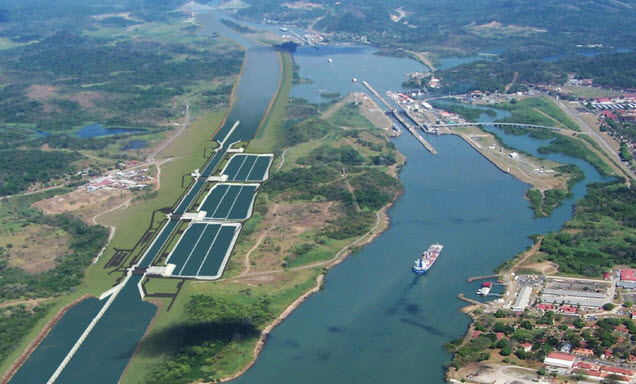Dozens of people crowded into the main hall of the Panama Canal Authority’s headquarters last month to see which ship would win the coveted maiden voyage through the expanded canal slated for June 26.
All eyes were on 9-year old Margarita Rivas Silvera as she stuck her hand in a metal cage and pulled out the winning name.
Cosco, a Chinese shipping company, won the chance to send one of its ultra-large vessels through the new expanded locks, which are longer, wider and deeper than the original ones completed in 1914. It took nearly a decade to expand the canal, at a cost of more than $5 billion, but the project is the pride, and the lifeblood, of Panama.
Still, the opening comes during difficult financial times for the shipping industry.
On a recent day, hundreds of workers were out in full force. At one end of three huge chambers of the new locks, a back hoe was scrapping up the remaining boulders at the water’s edge.
Waldo Chan of the Canal Authority said, “Exactly what they are doing right now” is putting on the final touches.
It’s been a long haul for Panama to get this far. Construction started back in September 2007. Cost overruns, labor fights and bitter legal disputes delayed opening by more than a year.
Nils Haupt of Hapag Lloyd, one of the world’s largest shipping companies, says the industry can now use its so-called neo-Panamax ships. Those mega-vessels hold almost three times the number of containers that fit on the biggest ships allowed through the canal now.
“If you have bigger ships, you know you can just take one big ship instead of two smaller ships, which for the shipping line is a big advantage,” says Haupt.
But Steve Fitzroy, a transportation consultant at the Economic Development Research Group, says the new canal opens at a time when commercial shipping has tapered off.
“Vessel operators have brought on a lot of large new vessels that are much bigger than have been operating in the past and demand is weak because of global economic concerns,” he says.

A tugboat and barge transporting NASA’s only remaining space shuttle external tank makes it through the Miraflores locks in the Panama Canal in April. The tank was headed to the California Science Center in Los Angeles as part of the Space Shuttle Endeavour display.
Arnulfo Franco/AP
Add to that the concern over water. This year’s El Niño climate pattern has left Panama with a longer than normal dry season. Last month, the Canal Authority had to restrict ship crossings through the old locks because of the lack of water.
Geological engineer J. David Rogers of Missouri University of Science and Technology says the expansion’s new locks have built-in reserve bays to save water. And he says, engineers built a new dam to allow for more water storage in the wetter years.
“Because it’s a precious resource, even in a place like Panama, where it rains constantly,” he says with a laugh.
For now, while the country waits for the new canal to finally open its gates, school kids continue to flock to the old locks.
Riczaery Ramos, 11, says it’s fantastic and beautiful to watch the big ships. If all goes according to schedule she’ll soon get to see even bigger ones, some of the largest in the world, come through her country.
